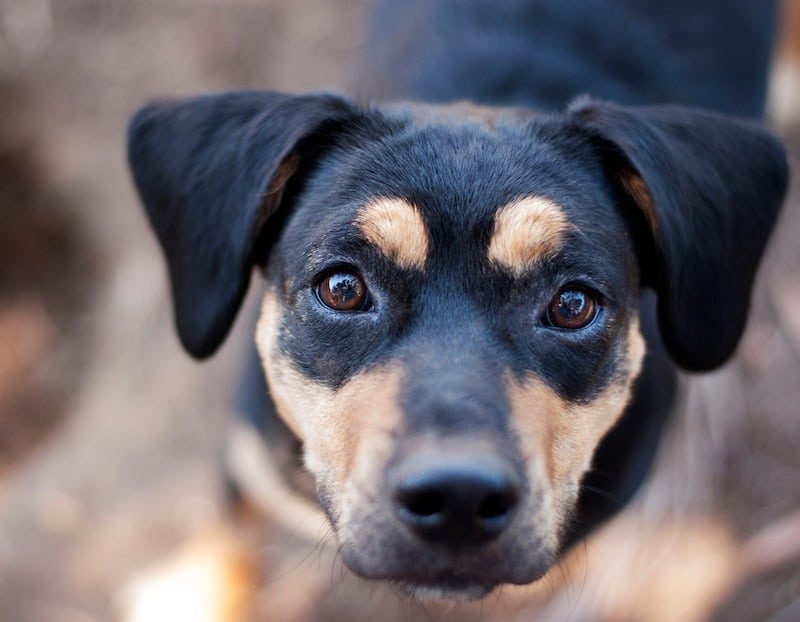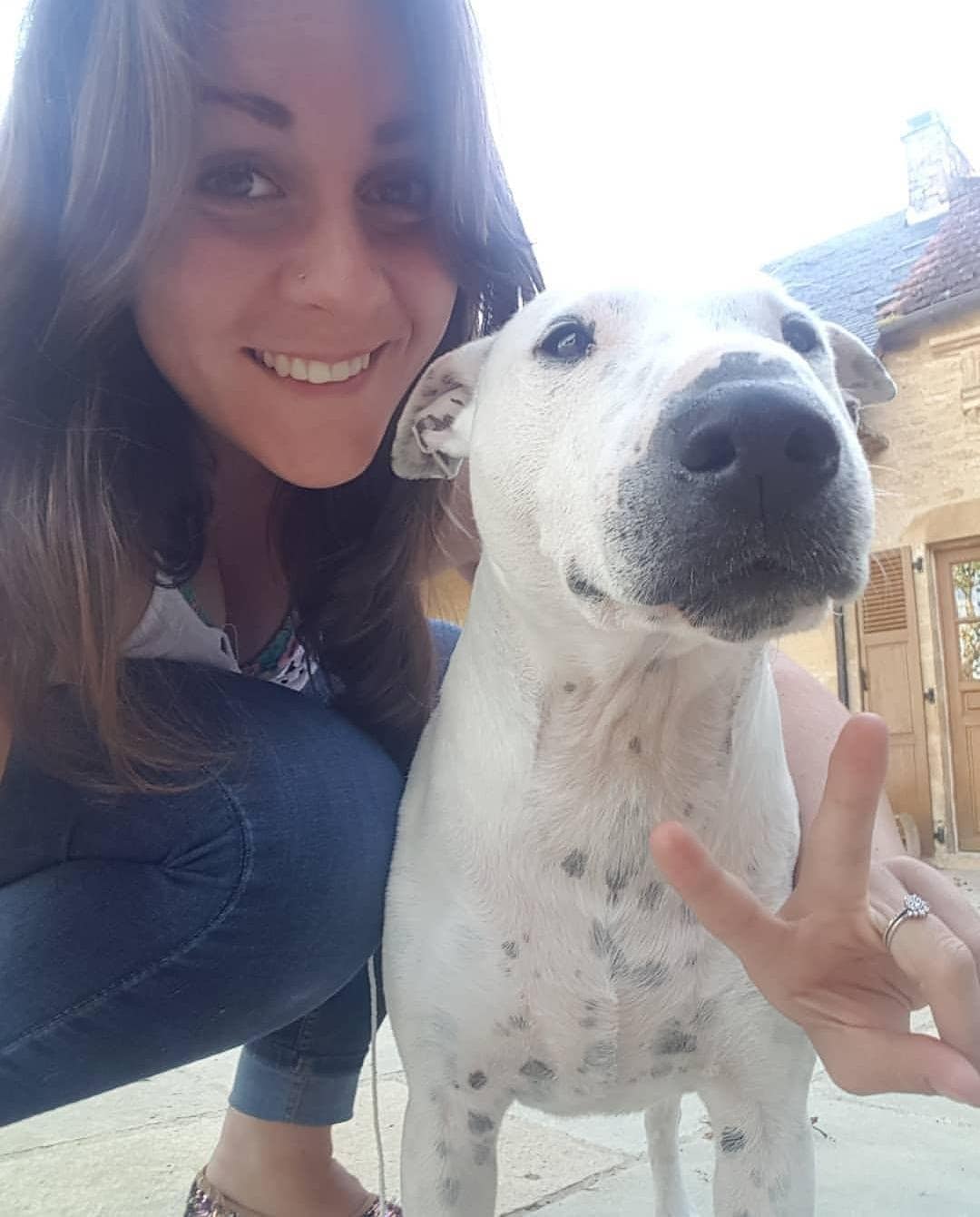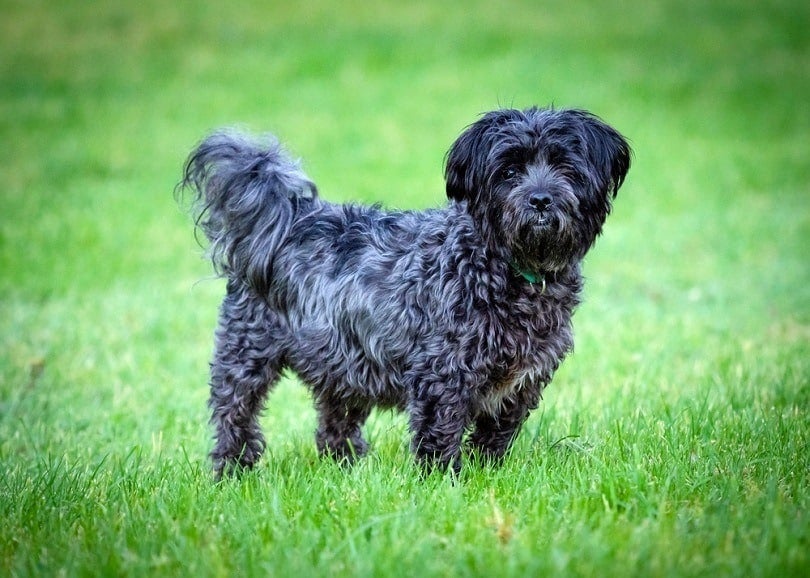Schnottie (Schnauzer & Rottweiler Mix): Info, Pics, Traits & Facts

Updated on
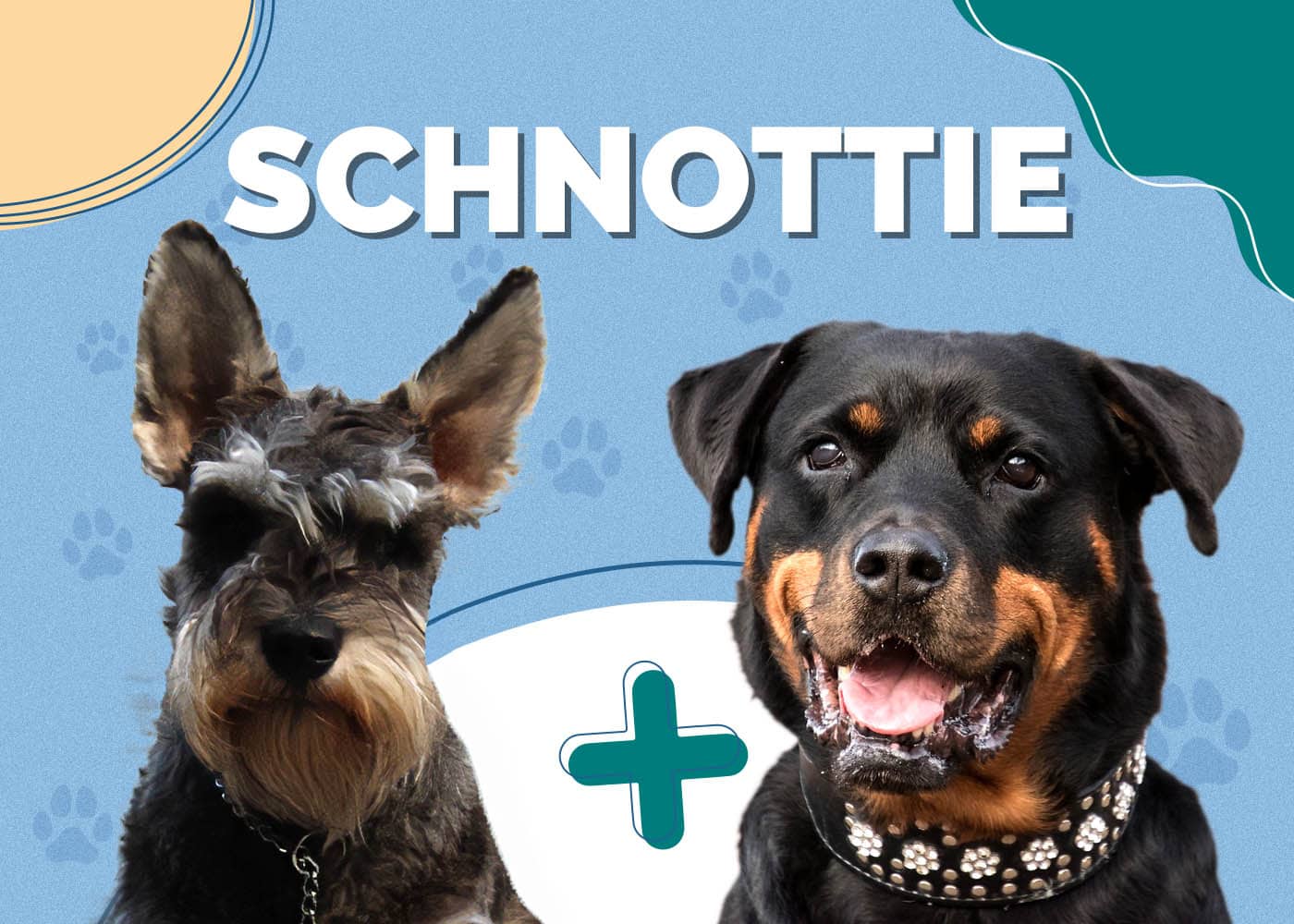
Height:
20-25 inches
Weight:
50-65 pounds
Lifespan:
12-15 years
Colors:
Sable, brown, gray, black
Suitable for:
Families and individuals looking for an active and loyal pet
Temperament:
Loyal, protective, energetic, gets along well with children
The Schnottie is a recent designer breed that is the result of crossing a Schnauzer with a Rottweiler. While there is little formal information available about the breed, both parent dogs are popular and well-known breeds. While the Standard Schnauzer is typically used in this crossbreed, some dogs are bred from the Giant Schnauzer, with the result being a considerably larger dog in terms of both size and weight. It is therefore important for prospective owners to check the parentage of any puppies that they are considering to ensure that they get the right dog for their circumstances.
Regardless of the parent dogs’ sizes, the resultant Schnottie puppy will likely have a medium to high energy level and be affectionate around their family, loyal, and quite protective.
Schnottie Puppies
The Schnottie is still a relatively new breed, and finding a reputable breeder in your area may be a challenge. If you can’t find a local breeder, we suggest keeping an eye out on social media and contacting other owners of the breed and asking them to recommend a breeder. However, when using these methods to find and purchase a pup, you need to exercise caution, as you may find yourself being directed to a puppy mill or to a less-than-ethical breeder who is more interested in making a quick sale than looking after the welfare of their dogs and developing the breed.
Once you have identified a breeder, you should make every effort to visit the breeder’s kennels in person to meet their dogs and assess for yourself the way that the breeder cares for their dogs.
One other thing to watch out for is that the breed name, Schnottie, is also sometimes used to describe a cross between a Miniature Schnauzer and a Scottish Terrier, which is a good breed in its own right but a very different dog from the one we’re talking about.
The price of a Schnottie will depend on both the availability of puppies and how much interest a breeder has in their dogs.
3 Little-Known Facts About the Schnottie
1. There are currently no written standards for the breed.
Since Schnotties are a relatively new hybrid breed, there are no written breed standards available to breeders or prospective owners. This is typical in the case of new breeds and should not put prospective owners off, as all it really means is that the breed is still under development and has not been recognized by any of the official kennel clubs. Of course, not being a recognized breed, you won’t be able to get any pedigree papers for your pup, but this makes no difference as to the nature of the dog. In fact, many people believe that mixed-breed dogs, such as the Schnottie, ultimately make the best pets.
2. Schnotties make good family watchdogs.
Given that both the Schnauzer and Rottweiler are protective dogs, it should be no surprise that this is a trait that will highly likely be inherited by a Schnottie. While having a dog that will watch over and help protect your family and your home is a plus for many people, it does also mean that the Schnottie may not get on well with strangers or other dogs. To avoid any problems later in life, Schnotties must be well-socialized from a very young age.
3. Both parent breeds are originally from Germany.
The Standard Schnauzer was developed in Germany in the early 1500s and was originally used to herd livestock, guard rural properties, and assist in vermin control. They were first brought to the United States by German immigrants in the early 1900s. However, the breed did not gain popularity until after World War I.
The Rottweiler was also developed in Germany and is part of the Mastiff family of dogs that spread across Europe with the invading Romans. After centuries of interbreeding with other local dogs, the Rottweiler became the popular breed that we know today.
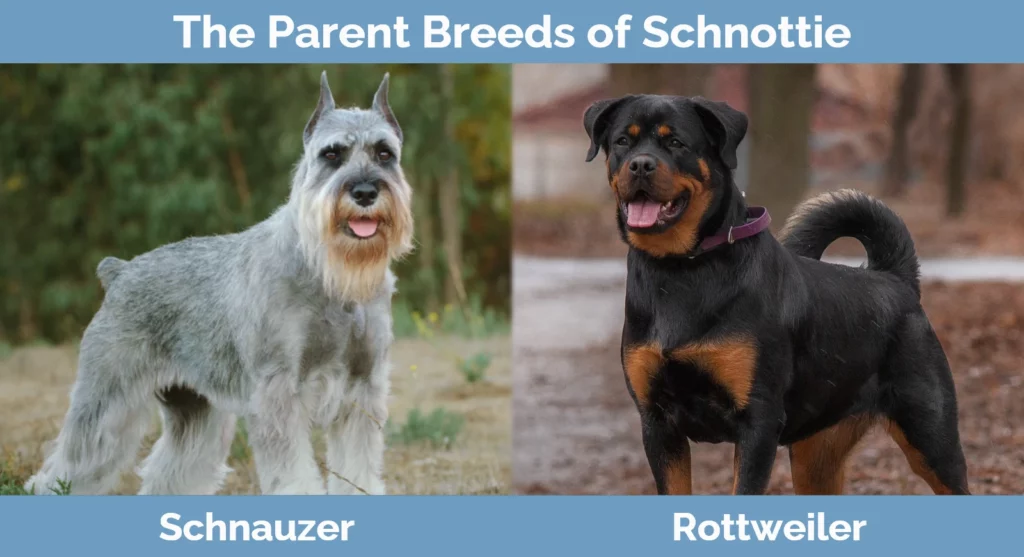
Temperament & Intelligence of the Schnottie 🧠
This designer dog comes from a long line of herding and protection dogs, so it should come as no surprise that they are loyal and dependable guardians. They are highly protective when it comes to their home and their family, and if not appropriately socialized, they can be a little over-aggressive toward strangers and other dogs.
Schnotties love being with their families and don’t do well when alone for long periods. When left to their own devices all day, Schnotties often resort to destructive behavior and digging as a means of entertaining themselves and may also develop an annoying barking habit.
Are Schnotties Good for Families? 🏡
The Schnottie is a loyal and loving dog that will form a close bond with their family. They are typically extremely good with children, and like both their parent breeds, they will modify their behavior around young children to ensure that they don’t inadvertently injure them.
The breed is also protective, and while this can be a benefit at times, you may need to take care in public if there are other dogs around, as their protective instinct can lead to aggressive behavior.
Do Schnotties Get Along With Other Pets? 🐶 😽
The Schnottie is not the best dog to have if you want to keep other animals, and they are best in single-pet households. It is certainly possible to train them to live with other animals, but you may find this more challenging than with some other breeds.
For the best chance of getting your Schnottie to play nice with other pets, it is important to ensure that your dog is well-socialized from a young age, and it may help to introduce the other pet into the family while your Schnottie is still a pup.
Things to Know When Owning a Schnottie
Food & Diet Requirements 🦴
Ensuring that your dog is given a complete and well-balanced diet is one of the most important things that you can do to help them live a long and healthy life. These days, this task is made easy by the fact that we have a multi-billion-dollar pet food industry that has spent thousands of man-hours and millions of dollars on the development of nutritional dog foods.
Finding good food for your dog is as simple as making a quick visit to your local pet supply store or visiting an online provider like Chewy. As with most things, when it comes to dog food, it is often the case of “you get what you pay for,” and as such, we recommend that you feed your dog a premium brand of dry dog food that has been formulated for large active dogs.
Schnottie Exercise 🐕
Schnotties tend to have a medium to high level of energy and are not dogs that should be kept in an apartment. They are best suited to living in a house with a large secure yard in which they can run about and play in.
Besides a good play session in the yard, Schnotties require a vigorous 30-45-minute walk each day, which is a great way to keep them fit and allows them to experience new things. It will also keep them mentally stimulated. However, as the breed often doesn’t mix well with other dogs, they must remain on a leash at all times when they are in public, and you would be well-advised to avoid taking them to your local dog park.
Schnottie Training 🦮
Schnotties respond well to training, but to ensure that they get the most out of it, you should start their obedience training from a young age. These can be quite strong-willed dogs, and due to their protective nature, an untrained Schnottie could easily become quite dangerous. For this reason, you should enroll them into puppy school as soon as possible when you take them home from the breeder, and once your pup starts to relax around other dogs, you should enroll them into obedience training.
While it may be tempting to hire a trainer to handle all their training, with these dogs, we strongly recommend taking the time to attend group classes once or twice a week with your dog and to conduct reinforcement training at home daily. Not only will this help them learn quickly, but the added exposure to other dogs and strange people will also help socialization and help cement your role as their master in their mind, thus ensuring that your dog learns to follow your directions.
Schnottie Grooming ✂️
How much grooming your Schnottie will require throughout their lifetime will largely depend upon which parent they most take after. If your pup has the wiry coat of the Standard Schnauzer, you may end up with a hypoallergenic dog that sheds exceedingly little and doesn’t require much in the way of general daily grooming.
However, if your pouch has the medium-length straight coat of their Rottweiler parent, you should expect to have a dog that sheds moderately and requires at least weekly brushing.
Health and Conditions ❤️
As the Schnottie is a new breed, there is not much information available about their health. However, based on the two-parent breeds, there are a few conditions that they may be susceptible to.
Many of these conditions are hereditary, and this is one of the most important reasons that you should only buy a puppy from a reputable breeder. Sure, they will be more expensive, but a good breeder will pay for the parent dogs to be screened for many of these health issues before breeding and should make the results of these checks available to you before you agree to buy a puppy.
- Cataracts
- Skin allergies
- Hip dysplasia
- Elbow dysplasia
- Pancreatitis
- Gastric dilation volvulus
- Epilepsy
Male vs. Female
When it comes to picking out your puppy, many people get worried about whether it is best to get a male or female puppy. However, unless you are planning on breeding from your dog or you prefer one sex over the other, this isn’t something that you should spend too much time worrying about.
Apart from a slight difference in height and weight, there isn’t a significant difference between male and female dogs. In whole dogs, there are a few temperamental differences, but these are minor at most and virtually non-existent once your dog is spayed or neutered.
A much better way to choose a puppy is based on their individual personality. If you spend time watching a litter of puppies, you can usually pick out the quiet puppies and the over-the-top boisterous ones quite quickly. Unless you are looking for a puppy with one of those personalities, we suggest picking one that is alert and curious but isn’t always roughhousing with their siblings. However, if you are at all unsure, talk to your breeder, as they will always do their best to match a puppy with the most appropriate owner.
Final Thoughts: Rottweiler Schnauzer Mix
As hybrid crossbreeds go, the Schnottie is a particularly good dog. They can make excellent pets, and provided that you’re prepared to put in the time socializing and training them, it is unlikely that you will have any major problems.
They are well suited to family life but do need a home that has a secure yard in which they can play, as they are not really suited to apartment living.
Keep in mind that these dogs are quite rare, and if you are looking to buy a Schnottie puppy, finding one might be the hardest part. You will need to be prepared to research breeders, and you may also need to travel out of your state to meet your chosen breeder and their dogs.
Related Reads:
- Golden Rottie Retriever (Golden Retriever & Rottweiler Mix): Info, Care Guide, Pics
- Samoyed Rottweiler Mix: Pictures, Care Guide, Temperament & Traits
Featured Image Credit: Pixabay


